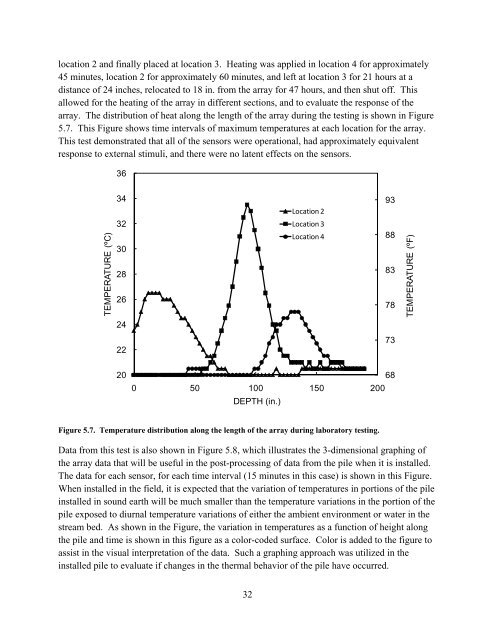Remote Health Monitoring for Asset Management
Remote Health Monitoring for Asset Management
Remote Health Monitoring for Asset Management
You also want an ePaper? Increase the reach of your titles
YUMPU automatically turns print PDFs into web optimized ePapers that Google loves.
location 2 and finally placed at location 3. Heating was applied in location 4 <strong>for</strong> approximately<br />
45 minutes, location 2 <strong>for</strong> approximately 60 minutes, and left at location 3 <strong>for</strong> 21 hours at a<br />
distance of 24 inches, relocated to 18 in. from the array <strong>for</strong> 47 hours, and then shut off. This<br />
allowed <strong>for</strong> the heating of the array in different sections, and to evaluate the response of the<br />
array. The distribution of heat along the length of the array during the testing is shown in Figure<br />
5.7. This Figure shows time intervals of maximum temperatures at each location <strong>for</strong> the array.<br />
This test demonstrated that all of the sensors were operational, had approximately equivalent<br />
response to external stimuli, and there were no latent effects on the sensors.<br />
36<br />
34<br />
Location 2<br />
93<br />
TEMPERATURE (ºC)<br />
32<br />
30<br />
28<br />
26<br />
Location 3<br />
Location 4<br />
88<br />
83<br />
78<br />
TEMPERATURE (ºF)<br />
24<br />
22<br />
73<br />
20<br />
0 50 100 150 200<br />
DEPTH (in.)<br />
68<br />
Figure 5.7. Temperature distribution along the length of the array during laboratory testing.<br />
Data from this test is also shown in Figure 5.8, which illustrates the 3-dimensional graphing of<br />
the array data that will be useful in the post-processing of data from the pile when it is installed.<br />
The data <strong>for</strong> each sensor, <strong>for</strong> each time interval (15 minutes in this case) is shown in this Figure.<br />
When installed in the field, it is expected that the variation of temperatures in portions of the pile<br />
installed in sound earth will be much smaller than the temperature variations in the portion of the<br />
pile exposed to diurnal temperature variations of either the ambient environment or water in the<br />
stream bed. As shown in the Figure, the variation in temperatures as a function of height along<br />
the pile and time is shown in this figure as a color-coded surface. Color is added to the figure to<br />
assist in the visual interpretation of the data. Such a graphing approach was utilized in the<br />
installed pile to evaluate if changes in the thermal behavior of the pile have occurred.<br />
32

















